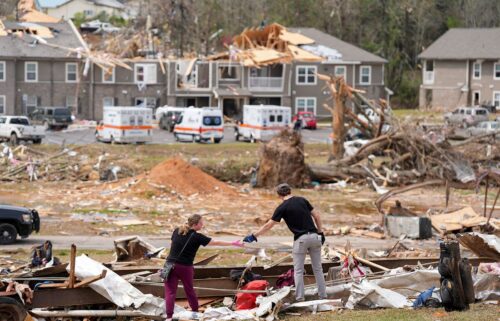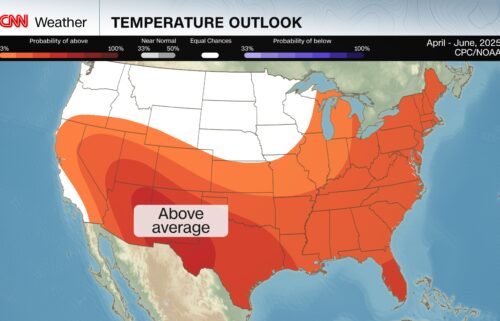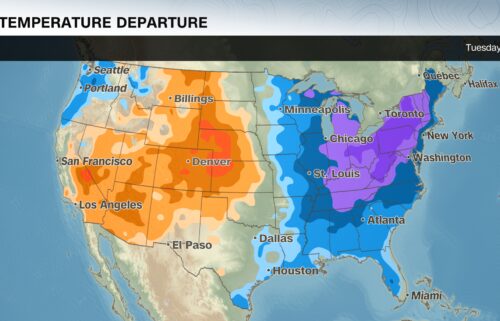Major winter storm set to deliver this winter’s most significant blow yet
PARK COUNTY SHERIFF’S OFFICE
By Mary Gilbert, CNN Meteorologist
(CNN) — A major winter storm will deliver heavy snow, hazardous ice, rain and severe thunderstorms to more than 1,300 miles of the United States over the weekend and into next week.
Snow and ice so far this winter in the eastern two-thirds of the country have been limited to northern states. But this storm will break that mold and bring treacherous conditions to millions from the Plains to the East Coast, including in areas less prone to winter weather.
And where it’s too warm for snow and ice, the storm could conjure up severe thunderstorms, including in some of the same areas still recovering from December’s deadly storms.
Major impacts, including “considerable disruptions to daily life … dangerous or impossible driving conditions and widespread closures,” are expected from this storm through Sunday in parts of the Central US, according to the Winter Storm Severity Index.
It all starts on Saturday afternoon when the storm develops in the Plains, fueled by a deep surge of moist air moving north out of the Gulf of Mexico. It will start to spread snow, rain and an icy mix over the Plains late in the day as it strengthens and expands.
From there it will track east and spread a wintry mess into the Mississippi Valley and parts of the Midwest by Sunday morning. The storm will expand into the Ohio Valley and Southeast Sunday and to the East Coast Sunday night and Monday.
The regions at greatest risk are clear, but exactly who gets snow, ice or mainly rain — and how much — is still incredibly difficult to determine. Small shifts in the storm’s track could change the outcomes entirely. Some areas could start as snow but change over to an icy mix as warmer air enters the area, while other spots start as rain or an icy mix and gradually change over to snow.
This storm will be capable of unleashing more than a foot of snow and enough ice to knock out power just as the coldest temperatures of the season arrive in its wake.
Snow will bury some areas
The storm will lay down several inches of snow from late Saturday through Monday in a stripe that stretches from parts of Kansas and Nebraska to the East Coast.
The highest snow totals will rack up in the coldest areas, likely in parts of Missouri, Illinois, Indiana, Ohio and West Virginia. Totals will be lower in areas where warmer air generates sleet and ice instead of snow.
St. Louis has only seen four days where more than a foot of snow fell in a day — a feat that could happen Sunday. Snow totals could range from an inch to more than a foot in parts of Missouri, depending on the storm’s exact track. This could also be the case for the other states with the greatest chances of snow.
Unlike during other storms this winter, Minnesota, Wisconsin, Michigan and Upstate New York could receive little-to-no snow because of the storm’s more southerly track. Some lake-effect snow is possible in Michigan and New York as the wind direction shifts both before and after the storm.
Treacherous ice to come
The greatest risk of dangerous ice will set up just south of the snowiest areas. Significant icing is possible from Kansas and Missouri through the central Appalachians and potentially parts of Maryland and Delaware.
Travel could be “nearly impossible” in the areas of heaviest icing, multiple National Weather Service offices warned.
Ice amounts of 0.25 inches or more are possible, especially in parts of southern Missouri, southern Illinois, southern Indiana and almost all of Kentucky.
Any amount of ice is dangerous; just a thin layer – a light glaze to just over 0.10 inches – can turn paved surfaces into skating rinks, causing people to slip and vehicles to slide out of control.
The thicker the ice, the worse its impact. Heavy ice – 0.25 inches or more – weighs down trees and power lines and can snap branches or pull down electrical wires. Large amounts of ice could also completely immobilize travel by making roads impassable.
An ice storm that slammed the Central US in January of last year knocked out power to thousands and sent first responders spinning out of control as they tried to reach people in distress.
Power outages could be widespread and long-lasting if significant icing occurs and power restoration crews can’t navigate treacherous roads. That situation could be dangerous or potentially deadly for those without access to heat in the extreme cold to come.
Damaging thunderstorms and soaking rain
The southern, warmer side of the storm will spread rain and some embedded thunderstorms over much of the South. Some of these thunderstorms could become severe, especially on Sunday afternoon.
A level 2 of 5 threat of severe thunderstorms is in place Sunday for parts of Texas, Louisiana, Arkansas and Mississippi, according to the Storm Prediction Center.
Damaging wind gusts and hail are the most likely threats from any severe thunderstorm but tornadoes are also possible. A tornado outbreak, including multiple rated EF3s, rocked parts of the South in late December.
Rain and storms could also cause flooding, especially where the heaviest rain falls in the Southeast.
The massive storm will finally exit the East Coast late Monday and fully diminish in impact overnight.
But Tuesday presents a new problem: Arctic cold. Temperatures will plunge as much as 30 degrees below normal for the eastern two-thirds of the US and the frigid air will last for some into at least the middle of January, locking in whatever snow and ice fall from the storm.
The-CNN-Wire
™ & © 2025 Cable News Network, Inc., a Warner Bros. Discovery Company. All rights reserved.



